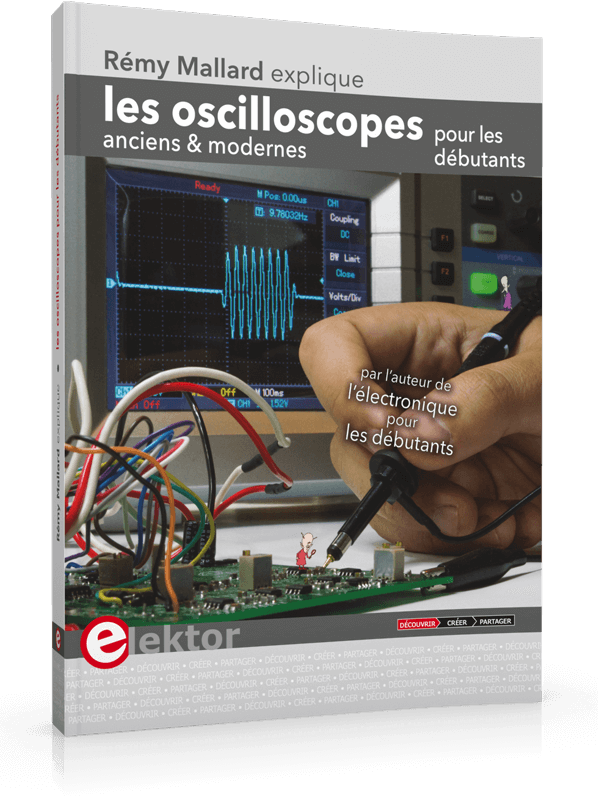Bandwidth
My first oscilloscope was a tube model with inputs on banana plugs and which never worked correctly (see page Right to error?). When I bought my first oscilloscope (Hameg HM203-4), I told myself that working mainly in the audio field (20 Hz to 20 kHz), a model with a bandwidth of a few MHz was more than enough. I realized over time that I was a bit wrong. I had the opportunity to design and make preamps that didn't work the first time and that provided beautiful HF oscillations that I could have done without. The parasitic oscillations can sometimes rise very high in frequency, it is not uncommon for them to reach several MHz, even several tens of MHz (and yes, even for an assembly supposed to work in audible frequencies). An oscilloscope with a bandwidth of 20 MHz no longer seems like a luxury to me.
Single or dual track?
Without any hesitation, I say double track! I almost always use two channels (especially for my audio editing), and occasionally 3 channels (I also have a four-channel A/D mixed oscillator). Of course, sometimes I use a single channel (signal verification at the output of a generator or a logic oscillator). You can't imagine how convenient and time saving a second way is! If you opt for a two-way, do not buy two probes, but three! A third probe may be useful for external triggering, which can simplify the visualization of signals that are sometimes a little difficult to "catch". More down-to-earth, this third probe can be a backup.
Analog or digital?
There was a time when the digital oscilloscope didn't even dare to show up at the local shopkeeper, because of course of its high price. There are now bench-top (normal size), transportable (reduced size) or portable (hand-held) oscilloscopes which are beginning to offer interesting performances for more reasonable prices, even if they are not yet really reach of all budgets. Be careful when choosing a digital oscilloscope, do not let yourself be trapped by the bandwidths announced by certain manufacturers, who have no qualms about notifying a bandwidth of 2 x 60 MHz while the input converters are clocked at the sampling frequency of 250 MS/s (mega samples - Samples - per second). Of course, we can say that a periodic signal of 60 MHz can be captured with a sampling frequency of 125 MS/s (half of 250 since the presence of two input channels, and the Shannon / Nyquist theorem is respected). But do you have any idea of the shape of the displayed signal? Nothing to do with reality, nor with what an analog oscilloscope of the same bandwidth can offer! The comparison can be made between a Tektronix brand oscilloscope, model TDS2002, which displays a bandwidth of 60 MHz for a sampling of 1 GS/s, and an Owon brand oscilloscope, model PDS6062T, which also displays a bandwidth of 60 MHz but for a sampling of 250 MS/s. We suspect that for the second the fidelity of restitution of the form of the acquired signal will be less good. For the Owon PDS6062T, it would have been wiser to talk about a bandwidth of 15 MHz, which, however, is sufficient for current needs. Do not spit on the numbers, especially when you know that the second costs half as much as the first! You just have to know what you're buying. For my part, I bought, in addition to my Hameg HM303 analog oscilloscope which always works well, a small portable oscilloscope to be connected to a PC. It's aboutPicoScope 2205 which gives me complete satisfaction (left photo below).
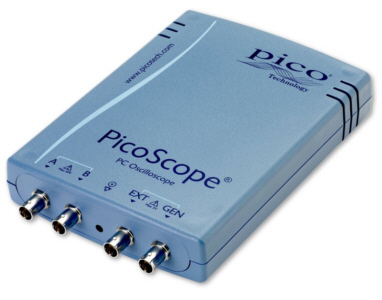
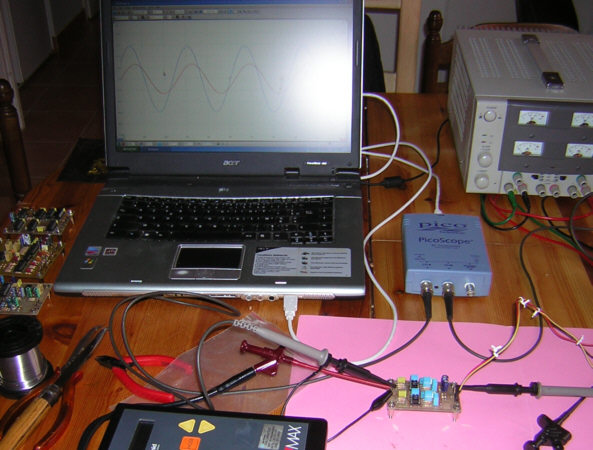
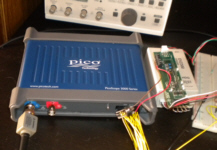
It is stable, offers spectral analysis (spectrum analyzer function very useful to have a good overview of the distortion on an audio signal for example, but I do not use it to make precise measurements), has a integrated signal generator (AWG, Arbitrary Waveform Generator) and allows direct capture of screens on PC, which changes me from manual photos of the screen of my analog model. It also has a serial data frame software decoding system, very useful for analyzing and debugging flows from I2C or SPI links for example (I used it several times to analyze SMBus frames on energy management systems with batteries).Picoscope 3204 MSO (photo on the left below) with a memory capacity of 128 Mpts (more than 2000 times higher than that of the Picoscope 2205). The Rigol company offers two models at less than 400 euros which can be interesting for the beginner: the DS1052 and the DS1102 (these two models have the same physical base but with different software). Myself owns the DS1054Z

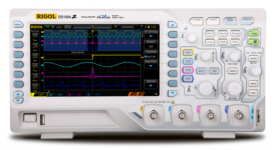
(photo on the right above) which I appreciate for its small size and comfortable screen. Remember, however, that entry-level digital models often have 8-bit resolution A/D converters, which is enough to see a "general" signal shape but not the small details on this "general" shape. For example, an overshoot of 100 mV at 150 kHz superimposed on a 1 V/1 kHz audio signal will not be correctly reproduced, we only see noise. For good visualization of "low amplitude" signals on an "insensitive" caliber, the input A/D converter must have a resolution of at least 12 bits.
Differential probe essential?
The classic probes supplied with the oscilloscopes only allow measurements referenced to ground (or earth) to be made. If you wish to visualize on the screen a signal taken with a traditional probe between two points of a circuit whereas neither of these two points is connected to the mass, that poses a serious problem. The mass of the probe, which is connected to the mass of the oscilloscope and to the earth, in fact causes a nice short circuit in this case! If you have an oscilloscope with two inputs and the polarity of one of the two inputs can be reversed, then it is possible to perform a differential measurement with two separate probes. But this remains an amateur solution, which does not offer the same degree of security as that offered by a real differential probe.
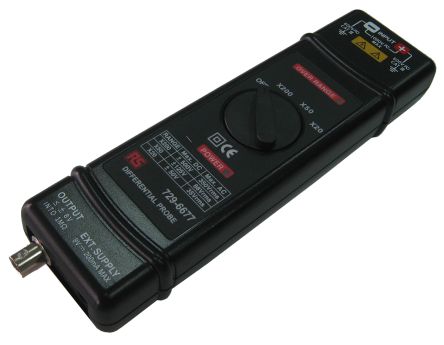
I own a "simple" Pintek DP-25 differential probe (purchased from Radiospare under their RS brand, pictured above). It does not offer extraordinary performance (bandwidth limited to 25 MHz and a bit "noisy") but it does make it possible to completely secure the oscilloscope, the device under test and... the user!
Buying a used analog oscilloscope?
Given the current market for new digital oscilloscopes, there are perhaps a few more analog oscilloscopes on the second-hand market today. For "small needs", an entry-level digital oscilloscope does the trick: not expensive, and full of functions that are not found on analog oscilloscopes. If you think an analog oscilloscope ad is worth it, perhaps you can check the following points before buying:
- focus: it must be possible to obtain a very fine line on the screen, which does not smudge step (button called Focus or Sharpness depending on device).
- light: the level of brightness should not be fully adjusted for normal viewing, if this is the case, the tube is too out of breath. If trace very little light with full light setting, not terrible.
- calibration: if the device is equipped with a Calibration output (often called Cal Out, and in the form of a small pin on which you can hang or insert the oscilloscope probe), you must check that this which comes out (rectangular signal of fixed frequency and fixed amplitude) is correctly displayed, both in amplitude and in time. If, for example, the signal supplied is a square of 1 MHz / 1 V peak to peak, check that the vertical transitions on the screen are well spaced by 1 division when the time base is at 500 ns / division (0.5 us / division) and that the number of divisions between the top and bottom of the gates is 5 divisions when the vertical sensitivity is set to 0.2 V / division. If no generator output for calibration on the oscilloscope, use a trusted external signal generator. That said, if the oscilloscope display is not completely respected, it is not very serious because the oscilloscope will always remain useful to see the shape and the "global" amplitude of the signals. Even if it is a little used, it remains a very valuable auxiliary.
- quality of contacts and general mechanics: move a little (without forcing) the connectors of the input(s) to which the probes are connected: the curve on the screen must not move. If it moves, there is a bad contact and that is very annoying. Similarly and always without getting excited like a leek who has just understood that he was going to go to the pan, manipulate the various switches, switches and potentiometers on the front panel. The curves must follow without jumping too much. There is nothing more annoying than seeing a trace that moves constantly on the screen because of a bad contact or a dirty potentiometer. Don't forget to test the horizontal and vertical position settings (offset) of the curve(s).
- mains supply: check on the back of the device if there is an input voltage switch. If so, prefer the 230 V position to the 220 V position (of course, especially not the 110 V position if it exists).
- detail if you have time to see it with the seller: turn on the device and let it heat up for 5 minutes, then start your checks. Then leave the device for about thirty minutes without touching it and replace the test cover. The overall behavior should be the same.
Before turning to a second-hand analog oscilloscope at 150 euros, be aware that there are new analog oscilloscopes for around 200 euros (1 channel) or 300 euros (2 channels), and digital oscilloscopes 2 x 40 MHz standalone at around 400 euros.
Tips for choosing and using an oscilloscope?
This book on oscilloscopes is from me, allow me to advertise it here ;)
